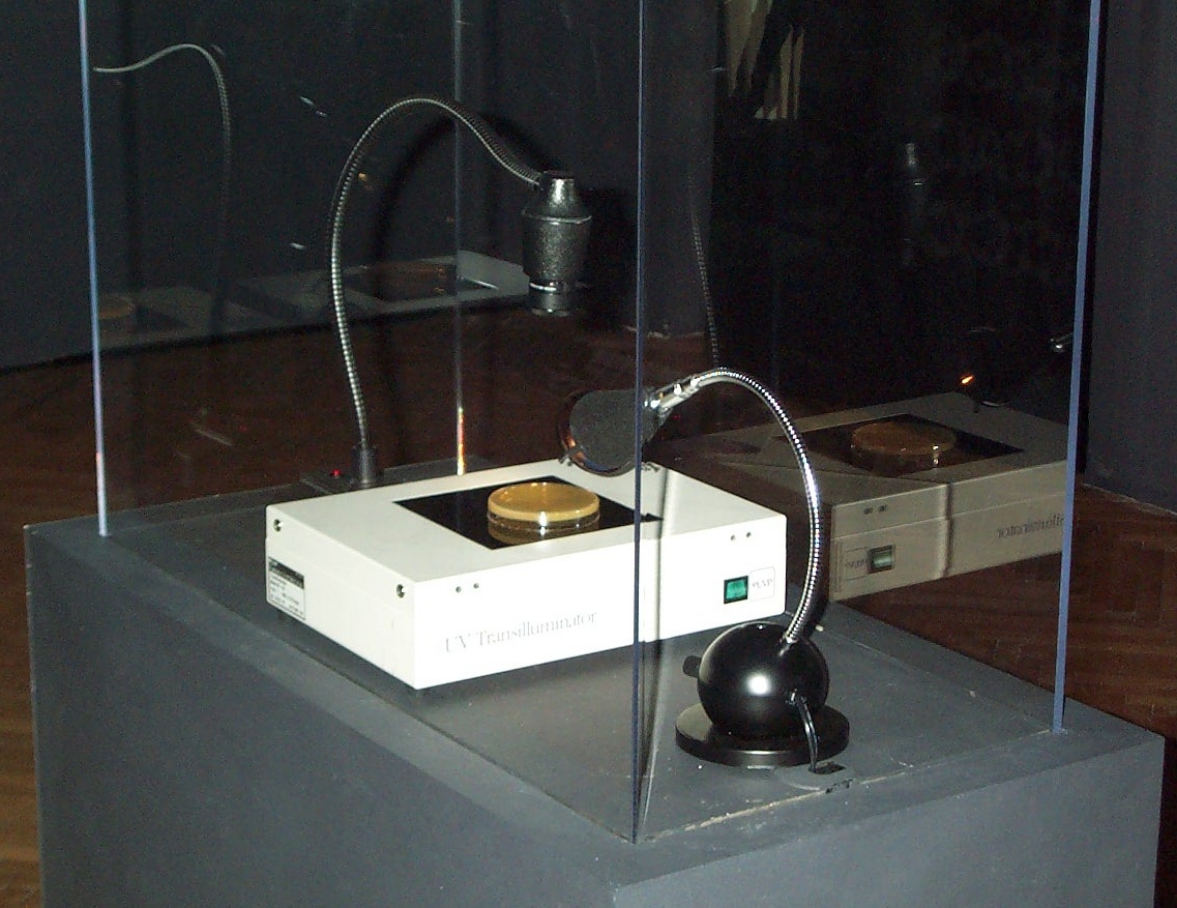媒體藝術界中頗具代表性的林茲電子藝術中心(Ars Electronica Center),早在1993年即以「基因藝術」(Genetic Art)為題策畫展覽,同年的研討會子題則包含「人造生命」、「基因工程」及「不朽的慾望(克隆、人體冷凍技術和化妝品)」等議題。1 2015年,臺灣生物藝術家林沛瑩與斯洛維尼亞藝術家胥貝拉.佩區克(Špela Petrič)等人共同創作之《植物性顧問公司》獲頒林茲電子藝術大獎混種藝術類榮譽提名,藝術家顧廣毅則於2019年以作品《虎鞭計畫》參與林茲電子藝術節主題展「人類侷限――有限人性」(Human Limitations-Limited Humanity)。「生物藝術」(Bio Art)在西方世界促進藝術、科技與科學共融的背景下,於過去十數年間儼然如雨後春筍(或許在生物藝術的脈絡下,我們應該改稱之為雨後野菇)般進入百花齊放的狀態,但究竟具備什麼樣性質的藝術創作可以被歸類在生物藝術之中?而我們在藝術結合科學眾聲喧嘩的討論中,又該如何為生物藝術劃定邊界呢?本文試圖爬梳1930年代以來具有生物藝術「徵候」的事件,並回顧創造「生物藝術」一詞的巴西美籍藝術家愛德華多.卡茨(Eduardo Kac)之過往創作及論述,藉以勾勒出生物藝術的樣貌。
1936年,紐約現代藝術博物館(Museum of Modern Art)推出了一檔史無前例的展覽:攝影師愛德華.史泰欽(Edward Steichen)同時也是一位雜交育種翠雀花多年的園藝家,他將翠雀花種子浸泡在秋水仙素溶液中,以誘發植物細胞的基因突變,再揀選體積上較為高大且具有奇異色彩如霧藍、薰衣草紫的翠雀花於美術館展廳中一字排開,以「探索翠雀花極致美學的可能性」的概念展出他歷時26年悉心研究的成品。為了這場別開生面的展覽「史泰欽式翠雀花」(Steichen Delphiniums),美術館在展覽新聞稿中亦強調:「為避免誤會,特此強調本展覽將展出翠雀花實物――並非以其影像為主題之繪畫或攝影作品。」2 當時現代主義運動對於創作材料的本質以及藝術的實際功能之討論還方興未艾,史泰欽正是在這樣的氛圍中展出他的翠雀花育種成果。他後來在《花園》(The Garden)雜誌中寫道:3
此後,隨著藝術家持續致力於媒材的探索,以及具突破性的創造性表現,包含植物及動物等的活體材料(living material)陸續出現在往後的藝術創作之中。1920年代受達達主義影響而崛起的超現實藝術浪潮,其訴求不受理性、傳統美學和道德規範束縛的創造性表現,考掘西格蒙德.佛洛伊德(Sigmund Freud)學說之意涵,亦從早先科學家的發現中汲取靈感。1938年,由法國超現實主義作家安德烈.布勒東(André Breton)和保羅.艾呂雅(Paul Éluard)共同策劃了「超現實主義國際大展」(Exposition Internationale du Surréalisme),其中薩爾瓦多.達利(Salvador Dalí)在參展作品《雨中計程車》(Rainy Taxi)中,讓活體蝸牛爬行在車體裝置中的人形模特兒身上。而普遍認為,史泰欽和達利是早期將活體生物用於藝術創作的藝術家,也引出日後對於「生物材料」作為創作媒介的藝術表現形式之討論。
到了1950到1970年代間,出現許多獨立發展的藝術運動,諸如行動繪畫(Action Painting)、偶發藝術(Happening)、激浪派(Fluxus)、維也納行動派(Viennese Actionism)等,當時新一代的藝術家尋求更加概念性和事實性的藝術創作方法,並也擁抱非傳統的媒材和創作過程。貧窮藝術(Arte Povera)先驅亞尼斯.庫奈里斯(Jannis Kounellis)在1969年展出活體馬匹;喬瑟夫.波伊斯(Joseph Beuys)在1974年的行為作品《我愛美國,美國愛我》(I Like America and America Likes Me)中與一匹土狼共處一室,以反映美國當時面對越戰和族裔對立的對峙狀態;維也納行動派藝術家則將肉身視為創作工具,作品中常見的體液、排泄物和血液等元素將他們推上道德禁忌的邊界;倡議藝術體制批判(Institutional Critique)的藝術家漢斯.哈克(Hans Haacke)則將包含生物與環境等的生態系統性概念納入其創作中。這時期的創作發展有些至今都仍顯前衛,但皆根植於20世紀初期對於媒材、創作過程和表現形式的實驗精神,人們對於創作媒材的理解發生了轉變,而觀者與作品之間的關係也隨之改變。
 胥貝拉.佩區克(Špela Petrič)的「Confronting Vegetal Otherness - Skotopoiesis, Phytoteratology, Strange Encounters」。圖 © Špela Petrič and Ars Electronica
胥貝拉.佩區克(Špela Petrič)的「Confronting Vegetal Otherness - Skotopoiesis, Phytoteratology, Strange Encounters」。圖 © Špela Petrič and Ars Electronica
幾世紀以來,西方世界的藝術和科學有著緊密的連結,直到近代科學的出現,才讓兩者開始疏遠,成為壁壘分明的兩個領域。不過在當今強調技術科學(technoscience)的時代,又讓這兩個領域有了重新交流的可能。過去30多年中,技術和科學逐漸成為現代社會的基礎,藝術家和科學家之間的合作因此愈來愈頻繁。4 但跨科際的藝術與科學合作並不是新的現象,1928年發現青黴素的蘇格蘭生物學家、藥學家亞歷山大.弗萊明(Alexander Fleming)除了致力於科學研究,也熱愛繪畫創作。他嘗試在洋菜膠上培養不同菌種,並依照各菌種生成的顏色和生長速度、型態進行排列,最後發展成培養皿上的細菌繪畫。匈牙利藝術家高爾基.凱布斯(György Kepes)歷經包浩斯(Bauhaus)運動的洗禮後,最終落腳於美國麻省理工學院(Massachusetts Institute of Technology)。他因為對抽象繪畫的興趣,也開始探究科學圖像的抽象藝術性,並在第二次世界大戰後,在麻省理工學院以藝術展的形式展出他所研究的科學影像,其後也致力於藝術、科學與科技的結合。
 亞歷山大.弗萊明(Alexander Fleming)除了致力於科學研究,也熱愛繪畫創作,他也在培養皿上以細菌作畫。圖/Alexander Fleming Laboratory Museum (Imperial College Healthcare NHS Trust)
亞歷山大.弗萊明(Alexander Fleming)除了致力於科學研究,也熱愛繪畫創作,他也在培養皿上以細菌作畫。圖/Alexander Fleming Laboratory Museum (Imperial College Healthcare NHS Trust)
而20世紀最重要的科學發現之一,可說是美國生物學家詹姆斯.華森(James Dewey Watson)和法蘭西斯.克里克(Francis Crick)在1953年繪製出的DNA雙螺旋結構,此後,相關研究如基因複製及轉錄等科學工程也隨之發展。基於電子技術和生物學上不斷突破的技術,1980年代起,藝術家如喬治.格賽爾特(George Gessert)、喬.戴維斯(Joe Davis)、賴瑞.米勒(Larry Miller)和史泰拉克(Stelarc)亦開始參與專門領域的科學研究並進行藝術創作。隨著時間的推移,愈來愈多的藝術家開始使用基因工程、組織培養或人造生命技術等方法和實踐進行創作,科學工具從而被大眾接受成為一種藝術表現手段。戴維斯被視為美國生物藝術之奠基者,他在1986年和哈佛大學遺傳學家達娜.博伊德(Dana Boyd)在實驗室中改造大腸桿菌,嘗試將圖像訊息編碼植入細菌的DNA之中,這件名為《微納斯》(Microvenus)的作品,即是第一個以分子生物學的技術發展出來的藝術創作。
一直到1997年,藝術家卡茨始在其作品《時間膠囊》(Time Capsule)中提出「生物藝術」一詞,後來相關的理論家及評論者才開始沿用這個詞彙來指稱結合「活體組織、細菌、生物體與生命過程」的藝術實踐。我們可以約略以這個時間點,將前生物藝術時期與生物藝術發展初期一分為二。卡茨在《Signs of Life: Bio Art and Beyond》一書中,針對這個概念解釋道:
生物藝術是當代藝術發展的一個新方向,它得以操縱生命運行的過程。在不同的情況下,生物藝術會使用以下一種或一種以上的方法進行創作:
(1)讓生物材料進入特定的惰性狀態或行為。
(2)以特殊或具顛覆性的方式使用生物科技工具和過程。
(3)發明或改造生物體,無論是否與社會或環境結合。5
卡茨的創作生涯始於1980年代,在網際網路尚未普及至全球的當時,他便致力於電子通訊藝術(telecommunication art)、遠距臨場藝術(telepresence art),他的創作皆圍繞在實驗詩歌、實驗書寫和視覺藝術等創作領域,並試圖發展新的詩歌語言,諸如以錄像、全息攝影、電腦程式和網路等形式表現新詩的可能性。隨著基因複製、嵌合生物(Chimera)和基因轉殖生物的研究發展,他開始以生物材料作為探索創作媒材的工具。在《媒體詩歌:國際論文集》(Media Poetry: An International Anthology)一書中,他即提出「生物詩」(Biopoetry)這個類型的創作,並定義其下諸如原子書寫(Atomic writing)、基因轉殖詩(Transgenic poetry)、阿米巴書寫(Amoebal scripting)、動態生物顏料合成(Dynamic biochromatic composition)、細菌詩學(Bacterial poetics)、組織文本(Tissuetext)等共計20種類別的創作實踐。6
卡茨長期探索人類、動物和機器之間的界線及交互關係,在《時間膠囊》這件場域限定(site-specific)的作品中,他將探索的目光移回自己的身上,並把自己的肉身和遠端資料庫做為創作場域,以電視和網路同步播送這個實驗性的探索過程。他把一塊具生物識別功能的微晶片植入自己的體內,這塊晶片是一個訊號發射器,若掃描晶片使其通電,晶片將會傳輸內部預先編寫好的數據,並顯示在掃描裝置上。而人體則會逐漸生成包覆住這塊微晶片的結締組織,使其固定不動。藉由這個實驗在網站和電視螢幕上的同步播送,卡茨也想凸顯全球數位網路所形成的結締組織,讓我們的皮膚不再是界定身體邊界的保護界線。
1998年,卡茨基於史泰欽和格賽爾特的植物育種創作,又提出了「基因轉殖藝術」(transgenic art)一詞,並在同名文章中,提出了宣言式的概念7,也進一步勾勒出「當代」生物藝術的可能性及不同面貌:
在這篇文章中,除了提出看似雄辯之詞的藝術策略外,他也宣告了正在進行的綠色螢光蛋白(Green fluorescent protein,GFP)研究。後來他在2000年發表了《GFP兔仔》(GFP Bunny)――一隻身上帶有水母基因、在藍光照射下會發出綠光的兔子。
 愛德華多.卡茨(Eduardo Kac)於1999年受林茲電子藝術節委託創作《創世紀》(Genesis)。圖/Dave Pape攝影、Public Domain
愛德華多.卡茨(Eduardo Kac)於1999年受林茲電子藝術節委託創作《創世紀》(Genesis)。圖/Dave Pape攝影、Public Domain
卡茨發表基因轉殖藝術後,在1999年受到林茲電子藝術節的委託,以《創世紀》(Genesis)一作,探究生物學、宗教信仰、資訊科技、倫理和網路之間的關係。他將聖經中「神讓人管理海裡的魚、空中的鳥和地面上各樣行動的活物」的章句,轉譯為摩斯密碼,再依照他為這件作品定義的轉換規則,將摩斯密碼轉譯為鹼基對,並對這種人類凌駕於自然的概念提出質疑。此後,生物藝術實踐便開始進入體制結構。藝術家歐仁.卡茲(Oron Catts)和艾歐蘭特.樂兒(Ionat Zurr)在1996年成立的「組織培養與藝術計畫」(Tissue Culture and Art Project),有了這個先例,西澳大學(University of Western Australia)在2000年成立合成生物實驗室(SymbioticA),讓藝術家和研究者得以進入生物實驗室,對生命科學進行研究、學習、批判和實作。美國倫斯勒理工學院(Rensselaer Polytechnic Institute)、荷蘭萊登大學藝術與基因中心(The Arts and Genomics Center, Leiden University)、芬蘭生物藝術協會(Finnish Bioart Society)、紐約視覺藝術學院生物藝術實驗室(Bioart Lab, School of Visual Arts, New York)、英國愛丁堡大學(University of Edinburgh)和美國史丹福大學(Stanford University)也都投入生命科學與藝術的合作研究。8
因為各機構、獎項和研究計畫對於生物藝術投注的種種關注,使得生物藝術在歐美地區一度蔚為熱門的創作及研究項目,加上生醫科技成為今日最熱門的科學領域,具趨勢敏銳度的實驗室也積極尋求與藝術家的合作,生物藝術日漸脫離1920年代以來對於創作媒材和方法的實驗性探索,而成為當代藝術界的流行詞彙。媒體研究學者揚斯.豪瑟(Jens Hauser)認為造成這種現象的原因,一方面是人文學科對於生物隱喻的使用不斷膨脹,另一方面,眾多的生物技術也為藝術家提供了源源不絕的創作主題和媒介。9 不過長時間以基因藝術主導的生物藝術隨著熱潮暫歇,也更擴大了創作視野,而將組織培養、神經生理學、人造DNA序列合成、生物技術、醫學實驗,以及分子生物學的視覺化等領域納入討論。
2017年,卡茨與格賽爾特、瑪莉詠.拉瓦勒-尚泰(Marion Laval-Jeantet)、班諾.曼剛(Benoît Mangin)、瑪爾塔.德梅內澤斯(Marta de Menezes)和保羅.凡諾斯(Paul Vanouse)等六位藝術家,在「生物藝術」一詞出現的20年後,再度針對此一概念提出一份宣言:10
何謂生物藝術:一份宣言
• 生物藝術指的是以生物物質連續體為創作媒材的藝術,從DNA、蛋白質和細胞到完整的有機體。生物藝術操縱、改變或創作生命以及生命過程。
• 在操縱生物過程時,生物藝術直接介入生命的網路。
• 生命有一種不可還原為其他媒介的物質特性。生命具有物質的特殊性,是其他媒介無法還原的。
• 沒有直接的生物干預,僅由壓克力、紙質、像素、塑料、鋼鐵或其他種類非生物物質製成的藝術都不是生物藝術。
• 所有藝術創作媒材都具有道德意涵,但當這些媒材還活著的時候他們最受壓迫。但當這些媒體還具有生命時,這種意義最為迫切。我們提倡一種合乎倫理的生物藝術:尊重人類和非人類的倫理道德。
• 有些生物藝術家使用活的媒材來表達人類的關切,有些藝術家則讚揚非人類生物以及彰顯人類與其之連結。
• 生物藝術沒有義務將生物學或生物相關的主題主題化。
• 我們相信藝術觀眾能夠理解認知,因為生物藝術是活的,所以具有政治、社會、文化以及道德意涵,無論藝術家是否明確表達了這些涵義。
• 生物藝術挑戰人類與非人類、生物與非生物、自然與非自然之間的界線。
• 本宣言從一開始就概括及重申了我們作品中所涉及的議題。
儘管這份宣言頗有為自己確立生物藝術正統地位的意味,生物藝術仍是一項持續發展的創作領域,並持續對社會、哲學、道德提出詰問,也值得我們持續保持觀察並且投身創作。最後,豪瑟也提到生物藝術創作先驅戴維斯對於這門藝術令人意外的小結:也許有天,我們不再稱之為生物藝術,而是純粹地稱其為「藝術」。11